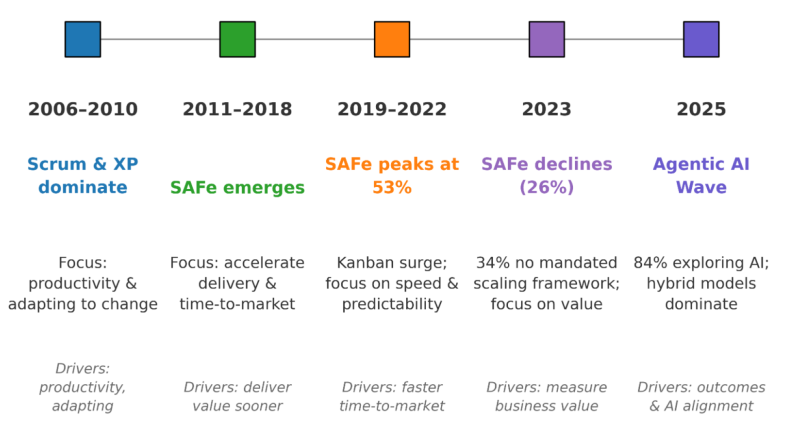I am a big fan of the annual State of Agile report from Digital.ai. Each year, the report looks at things like why organizations adopt Agile, what frameworks they use, and what challenges they’re facing.
But this year was different. For the first time in its 18-year history, Digital.ai didn’t ask about team-level frameworks. They didn’t ask why teams choose Agile. They didn’t even discuss (much) about scaling approaches. Instead, the entire report turned its spotlight on something else entirely: AI, of course.
Here are the key insights from this year's report. Or you can download your own copy at www.stateofagile.com.
1. AI Jumps From Assistant to Autonomy
This year's report refers to the current state of AI as the Fourth Wave of software development: Agentic AI. We’re not just talking about tools that generate test cases or summarize tickets. We’re talking about AI systems that act, decide and optimize. And sometimes outperform humans on routine decisions. No, we're not talking about the Terminator's Cyberdyne Systems - not yet, anyway - but organizations are using AI in new ways:
84% are using or planning to use AI in the development lifecycle
1 in 4 already have agentic AI pilots doing actual decision-making
Teams are beginning to treat AI as a collaborator, with Retrospectives, governance, and feedback loops that include AI-generated work
2. The Visibility Paradox: More Light, Worse Outcomes
Here's something that both surprised and didn't surprise me: organizations claim they have more visibility than ever. 55% say they have end-to-end SDLC visibility. 65% say their toolchain is well aligned.
But at the same time, 63% report declining software quality, and teams say they’re delivering slower, even with better reporting. This paradox—more visibility, worse results—is coming from a misuse of metrics from leadership. Only 15% of business leaders participate meaningfully in Agile practices, and leadership alignment is now one of the top blockers to success.
To address this, I strongly recommend that leaders take the Professional Agile Leadership course which includes everything from the leader's role in Agile to using the right metrics to drive alignment. Leadership support is critical for the success of Agile teams, but leaders need to think about leading differently in complex environments.
3. The Rise of Hybrid Everything
Although SAFe does remain the most popular scaling framework, we are seeing the industry slowly start to shift towards more diversity in scaling frameworks.
SAFe usage has dropped to 44% (down from 53% at its peak)
Adoption of Scrum@Scale, LeSS, and Nexus also declined
Meanwhile, 74% of organizations now say they use hybrid or homegrown models
The industry is quietly moving toward flexible, context-driven operating models. Teams are mixing Agile, DevOps, Product Ops, and even ITSM—whatever helps them deliver value.
This shift confirms something many practitioners have felt for years: the framework is less important than how you apply the framework. I am very excited - personally - about the potential of the product model as a way to gain alignment when combined with simpler and more flexible frameworks like Nexus.
4. The New Bottleneck: Data Trust Is Falling Apart
If AI is going to make decisions, the data feeding it better be trustworthy. And according to the report… it’s not.
Organizations admit:
53% struggle to prioritize work because their insights are unreliable
52% can’t measure business outcomes effectively
Nearly half still rely on spreadsheets
Only 6% use AI-driven analytics at scale
The result? Teams are moving faster, but not necessarily smarter. Digital.ai sums it like this: “AI without strong data governance creates acceleration without alignment.”
This may be one of the most important warnings in the entire report. The upshot: Context is important. We may need Context Owners in addition to Product Owners in the future. (Contact Rebel Scrum to learn more about our Foundational AI training options which includes workshops around creating a roadmap for AI and building a focus on context for your AI)
5. Agile Emphasizes Outcomes Over Outputs
The most refreshing trend this year is a return to Agile’s original purpose: delivering value. Previous reports obsessed over time-to-market, delivery speed, and automation. This year? The top cultural focus is:
Outcome-driven alignment
Adaptability across business & technology
Continuous measurement of value
Only 13% say Agile is fully embedded across their business—but nearly 29% say the next big leap is a culture centered on outcomes.
It seems to me like Agile is growing up, because it's less about using Agile for the sake of using Agile and more about focusing on business outcomes. We are moving beyond story points and sprint charts into something bigger: a value-driven operating model for the AI age.
Conclusion
I expect that we can continue to see the following trends this year:
AI acceleration (obviously!)
A focus on leadership alignment (much needed)
Building context in our data
The Product Model (or aligning teams around Products)
Increased focus on business outcomes
The next era of Agile won’t be defined by frameworks—it will be defined by alignment, data, and intelligent systems.
Scrum isn’t going away. Agile isn’t fading. They’re evolving into something more powerful: teams are using AI to help them deliver value by bringing AI on not as a tool, but a teammate on an Agile team.

